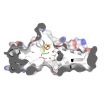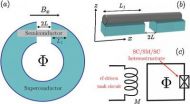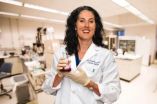(Press-News.org) This press release is available in German.
The iron-sulfur protein IspH plays a central role in the terpene metabolism of several pathogens. The mechanism of the reaction provides an approach for developing new antibiotics, particularly against malaria and tuberculosis. While researching this enzyme, biochemists at the Technische Universitat Munchen discovered a previously unknown reaction: IspH accepts two completely different classes of molecules as partners. This surprising insight, published in Nature Communications, opens up new perspectives in combating infectious diseases.
Terpenes constitute one of the largest and most versatile classes of natural compounds – familiar examples are cholesterol and estrogen. In all organisms the biosynthesis of terpenes starts from the two building blocks isopentenyl-diphosphate (IPP) and dimethylallyl diphosphate (DMAPP); however, mammals and bacteria use different biosynthetic pathways to do this. In bacteria and pathogenic microorganisms the enzyme IspH catalyzes the last step in the production of IPP and DMAPP. Thus for several years scientists have recognized the potential of IspH as a point of attack in developing drugs against malaria and tuberculosis.
Now Prof. Michael Groll and Dr. Ingrid Span at the TUM Chair of Biochemistry have made a significant breakthrough in this area. They have been working with Prof. Eric Oldfield and his group at the University of Illinois to characterize certain acetylene compounds that inhibit the IspH enzyme. With the aid of X-ray crystallography, they discovered that the enzyme not only binds several of these molecules to its active site but also modifies them: Through the additionof water to the acetylene groups (hydrocarbons with triple bonds), the compounds are converted to aldehydes or ketones. "In general enzymes react with only one specific substrate," explains Ingrid Span. "So we were surprised to find that IspH, in contrast, accepts two completely different classes of molecules."
IspH owes its flexibility to the structure and location of its active site. The enzyme is composed of three structural units that harbor a cubic iron-sulfur cluster at their center. This unusual structure enables the enzyme to accomplish a challenging reaction: converting an allyl alcohol to a mixture of the two isoprene components. While iron-sulfur proteins normally act as electron transmitters (), the IspH enzyme binds the substrate directly to the iron-sulfur cluster.
Apart from acetylene hydratase and nitrogenase, IspH is just the third enzyme known to convert acetylene compounds. In addition, until now there were no known iron-containing catalysts that could carry out this reaction. Thus the newly discovered property of IspH could enable the development of new active pharmaceutical ingredients, particularly for the battle against malaria and tuberculosis.
This work was carried out in the bioinorganic department of the Chair of Biochemistry. Bioinorganic chemistry is concerned with elucidating the function of classical "inorganic" elements, especially metals, in biological processes and in nature. Here, metalloproteins (proteins with one or more metal ions or clusters) play a particularly important role as they combine the advantages of proteins (acid/alkaline catalysis, proximity of reaction partners, enclosed reaction space) with the versatile catalytic properties of metals. "The aim of our research is to understand enzymatic reactions and to produce new catalysts, to establish the foundation for applications in the chemical and pharmaceutical industries," explains Michael Groll.
INFORMATION:
The work was funded by grants from the German Research Foundation (DFG - GR1861/5-1), the NIH Funds GM65307 and AI074233, the Hans-Fischer Society, and the American Heart Association Predoctoral Fellowship 10PRE4430022, as well as the Excellence Cluster "Center for Integrated Protein Science Munich" (CIPSM). The measurements were carried out using the PXI and PXIII beamlines at the Paul Scherrer Institute (Villigen, Switzerland).
Original publication:
Span I., Wang K., Wang W., Zhang Y., Bacher A., Eisenreich W., Li K., Schulz C., Oldfield E. and Groll M. (2012). Discovery of an Acetylene Hydratase Activity of the Iron-Sulfur Protein IspH. Nat Commun., 3 (1042), 1-8.
Contact:
Prof. Dr. Michael Groll
Technische Universität München
Chair of Biochemistry
Tel: +49 89 289 13361
E-Mail: michael.groll@ch.tum.de
IspH -- a protein free to choose its partners
Bioinorganic: Iron-sulfur enzymes as candidates for antibiotic development
2012-10-09
ELSE PRESS RELEASES FROM THIS DATE:
Scientists discover gene behind rare disorders
2012-10-09
Scientists at the Montreal Neurological Institute and Hospital – The Neuro, McGill University working with a team at Oxford University have uncovered the genetic defect underlying a group of rare genetic disorders.
Using a new technique that has revolutionized genetic studies, the teams determined that mutations in the RMND1 gene were responsible for severe neurodegenerative disorders, in two infants, ultimately leading to their early death. Although the teams' investigations dealt with an infant, their discovery also has implications for understanding the causes of ...
Chaperone protein subverts removal of glaucoma-causing protein
2012-10-09
Tampa, FL (Oct. 8, 2012) -- The chaperone protein Grp94 can interfere with the clearance of another protein known to cause the glaucoma when mutated, a new study led by researchers at the University of South Florida has found. Using a cell model, the researchers also demonstrated that a new specific inhibitor of Grp94 facilitates clearance of the genetically-defective protein, called myocilin, from cells.
Reported online this month in JBC (The Journal of Biological Chemistry), the discoveries could lead to a new treatment for some hereditary cases of glaucoma, an eye ...
Topological superconductors
2012-10-09
If quantum computers are ever going to perform all those expected feats of code-breaking and number crunching, then their component qubits---tiny ephemeral quantum cells held in a superposition of internal states---will have to be protected from intervention by the outside world. In other words, decoherence, the loss of the qubits' quantum integrity, has to be postponed. Now theoretical physicists at the Joint Quantum Institute (JQI) and the University of Maryland have done an important step forward to understand qubits in a real-world setup. In a new study they show, ...
Bioenergy - The broken promise
2012-10-09
Biofuels are going to save us from climate threats and the oil crisis, while at the same time providing an opportunity to the smallholder farmers of the world. Hopes are high, but completely unrealistic. It is like trying to push a square peg into a round hole, according to a current thesis at Linköping University.
Bioenergy could replace fossil fuels and solve the looming energy crisis. Into the bargain, we will benefit from reduced greenhouse gas emissions. A further bonus could be that demand for biofuels gives a lift to smallholder farmers in poor countries, who would ...
Doubling up on advanced prostate cancer with PARP inhibitors
2012-10-09
A newly discovered function of PARP-1 could be the key to more effective therapeutics to treat advanced prostate cancer patients, a recent preclinical study published in Cancer Discovery by Jefferson's Kimmel Cancer Center researchers suggests.
The team, led by Karen E. Knudsen, Ph.D., Professor in the Departments of Cancer Biology, Urology, & Radiation Oncology at Thomas Jefferson University, found that functions of PARP-1 not only include DNA damage repair but also androgen receptor (AR) regulation in advanced prostate cancer growth and progression. PARP inhibition ...
Chronic kidney disease alters intestinal microbial flora, UCI study finds
2012-10-09
Irvine, Calif., Oct. 9, 2012 – Chronic kidney disease changes the composition of intestinal bacterial microbes that normally play a crucial role in staving off disease-causing pathogens and maintaining micronutrient balance, according to UC Irvine researchers.
This profound alteration of the gut microbial population may contribute to the production of uremic toxins, systemic and local inflammation, and nutritional abnormalities present in patients with advanced renal disease, they said.
Study leader Dr. N.D. Vaziri of the UCI School of Medicine's Division of Nephrology ...
Drawing a line, with carbon nanotubes
2012-10-09
CAMBRIDGE, Mass. -- Carbon nanotubes offer a powerful new way to detect harmful gases in the environment. However, the methods typically used to build carbon nanotube sensors are hazardous and not suited for large-scale production.
A new fabrication method created by MIT chemists — as simple as drawing a line on a sheet of paper — may overcome that obstacle. MIT postdoc Katherine Mirica has designed a new type of pencil lead in which graphite is replaced with a compressed powder of carbon nanotubes. The lead, which can be used with a regular mechanical pencil, can inscribe ...
Academic achievement improved among students active in structured after-school programs
2012-10-09
School-age children who participate in structured after-school activities improve their academic achievement, according to a new study from Southern Methodist University, Dallas.
The study by researchers in SMU's Simmons School of Education and Human Development measured academic performance of students enrolled in Boys and Girls Clubs of Greater Dallas.
"Boys and Girls Clubs of Greater Dallas and other structured programs are really having a positive impact," said Ken Springer, an associate professor. "We believe that the homework support that the clubs consistently ...
How cancer cells break free from tumors
2012-10-09
CAMBRIDGE, MA -- Although tumor metastasis causes about 90 percent of cancer deaths, the exact mechanism that allows cancer cells to spread from one part of the body to another is not well understood. One key question is how tumor cells detach from the structural elements that normally hold tissues in place, then reattach themselves in a new site.
A new study from MIT cancer researchers reveals some of the cellular adhesion molecules that are critical to this process. The findings, published Oct. 9 in Nature Communications, offer potential new cancer drug targets, says ...
Online attitudes predict individuals' compulsive and excessive Internet use and poor well-being
2012-10-09
Among the most popular questions addressed in online communication research is the extent to which Internet use leads to undesirable psychosocial outcomes such as depression and loneliness. Evidence suggests that certain motivations to communicate online can have negative consequences, as the Internet itself can, for some, serve as an object of compulsive use. Individuals' compulsive Internet use (CIU) refers to their inability to control, reduce, or stop their online behavior, while excessive Internet use (EIU) is the degree to which an individual feels that he or she ...
LAST 30 PRESS RELEASES:
Making lighter work of calculating fluid and heat flow
Normalizing blood sugar can halve heart attack risk
Lowering blood sugar cuts heart attack risk in people with prediabetes
Study links genetic variants to risk of blinding eye disease in premature infants
Non-opioid ‘pain sponge’ therapy halts cartilage degeneration and relieves chronic pain
AI can pick up cultural values by mimicking how kids learn
China’s ecological redlines offer fast track to 30 x 30 global conservation goal
Invisible indoor threats: emerging household contaminants and their growing risks to human health
Adding antibody treatment to chemo boosts outcomes for children with rare cancer
Germline pathogenic variants among women without a history of breast cancer
Tanning beds triple melanoma risk, potentially causing broad DNA damage
Unique bond identified as key to viral infection speed
Indoor tanning makes youthful skin much older on a genetic level
Mouse model sheds new light on the causes and potential solutions to human GI problems linked to muscular dystrophy
The Journal of Nuclear Medicine ahead-of-print tip sheet: December 12, 2025
Smarter tools for peering into the microscopic world
Applications open for funding to conduct research in the Kinsey Institute archives
Global measure underestimates the severity of food insecurity
Child survivors of critical illness are missing out on timely follow up care
Risk-based vs annual breast cancer screening / the WISDOM randomized clinical trial
University of Toronto launches Electric Vehicle Innovation Ontario to accelerate advanced EV technologies and build Canada’s innovation advantage
Early relapse predicts poor outcomes in aggressive blood cancer
American College of Lifestyle Medicine applauds two CMS models aligned with lifestyle medicine practice and reimbursement
Clinical trial finds cannabis use not a barrier to quitting nicotine vaping
Supplemental nutrition assistance program policies and food insecurity
Switching immune cells to “night mode” could limit damage after a heart attack, study suggests
URI-based Global RIghts Project report spotlights continued troubling trends in worldwide inhumane treatment
Neutrophils are less aggressive at night, explaining why nighttime heart attacks cause less damage than daytime events
Menopausal hormone therapy may not pose breast cancer risk for women with BRCA mutations
Mobile health tool may improve quality of life for adolescent and young adult breast cancer survivors
[Press-News.org] IspH -- a protein free to choose its partnersBioinorganic: Iron-sulfur enzymes as candidates for antibiotic development


